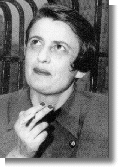
Ayn Rand and Objectivism:
An Introduction
The author
![]()
The founder of Objectivism, Ayn Rand (ne้ Alissa Zinovievna Rosenbaum), was born in St. Petersburg, Russia, on February 2, 1905. Ayn Rand attended Petrograd (Leningrad) University from 1921 to 1924 in the tumultuous period following the Revolution, where she majored in history, and took a minor in philosophy.
In early 1926, Ayn Rand fled the Soviet Union and arrived in New York City, during the "Roaring Twenties." It was her relatives in Chicago who made it possible for her to leave the Soviet Union, and with whom she first stayed after arriving in the U.S. After changing her name to Ayn Rand, she left Chicago for Hollywood, and eventually found work as a reader at Cecil B. DeMille's studio. On the set of DeMille's King of Kings, she spied a tall, handsome man named Frank O'Connor--and they were married in 1929.
During the Depression, Rand began to focus on her writing, producing several short stories and plays (these early works are collected in The Early Ayn Rand) as well as Night of January 16th ("Penthouse Legend" on Broadway), We the Living (Macmillan, 1936) and the dystopic Anthem (1938), written as a side project while working on The Fountainhead.
Ayn Rand's first major commercial success, The Fountainhead was published by Bobbs-Merrill in 1943 after being rejected by a dozen publishers as too intellectual. It is the story of an architect of fierce integrity who will permit nothing to compromise his creative vision or his sense of justice. In an exchange of letters from the spring of 1944, the great architect Frank Lloyd Wright wrote to Miss Rand:
I've read every word of The Fountainhead. Your thesis is the great one. Especially at this time. So I suppose you will be set up in the marketplace and burned for a witch."
Rand replied:
... I can't be "burned for a witch," because I think I am made of asbestos."*
The book was made into a full-length film and released by Warner Brothers in 1949, starring Gary Cooper as Howard Roark, Patricia Neal as Dominique Francon, and Raymond Massey as Gail Wynand. The film garnered luke-warm reviews at best, despite (or because of) Rand's full control over the screenplay, as well as superb sets and soundtrack. Perhaps Rand's best screenplay was not based on her own work but was her screen adaptation of Love Letters (1944), starring Jennifer Jones and Joseph Cotten. This is the archetype of "those great old black & white movies."
We the Living was also released as a full-length film in Italy in 1943, though when the Fascists finally figured out that the anti-communist message of the film was implicitly anti-fascist as well, it was banned by Mussolini. The book was re-issued in 1959 with minor editorial changes.
Ayn Rand's magnum opus, Atlas Shrugged (Random House, 1957) is arguably the most important work of fiction of the twentieth century. This 1168-page novel dramatizes the premises of her philosophy, which she named "Objectivism." Atlas Shrugged secured a place in history for its author, and forty years after its publication, has sold over 5 million copies. It is still selling well over 100,000 copies per year. In a poll conducted in 1991 by the Book of the Month Club, Atlas Shrugged was listed as the book that had changed readers' lives more than any other book, except The Bible.
For information and on-line
ordering of these books, visit:
For more books, audiotapes and videotapes on Objectivism, visit:
|
Around 1960, Miss Rand turned her attention to non-fiction, writing dozens of essays and delivering many public lectures on subjects traversing the entire domain of philosophy. Most of her essays originally appeared in The Objectivist Newsletter, The Objectivist and The Ayn Rand Letter, along with several articles by Nathaniel Branden, and were republished as anthologies (by New American Library). These included:
The Virtue of Selfishness (1964)
Capitalism: The Unknown Ideal (1967)
The New Left: The Anti-Industrial Revolution (1971)
The Romantic Manifesto: A Philosophy of Literature (1971)
Two more collections of essays and addresses were published posthumously by Leonard Peikoff:
Philosophy: Who Needs It (1982)
The Voice of Reason: Essays in Objectivist Thought (1988)
Ayn Rand died in New York City in March 1982.
Biographical Sources |
|
Next: Objectivism
- Overview ![]()
(c) 2000 Full Context